

12 Quiet Rituals of Enormously Successful Humans. May your actions speak louder than your words.
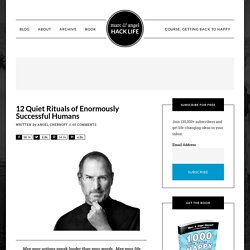
May your life preach louder than your lips. May your success be your noise in the end. The result of enormous success is often pretty noisy – lots of people talking, writing and sharing stories about it. The actual process of achieving enormous success, on the other hand, is far more discreet. But it’s this process that happens quietly, behind-the-scenes, that makes all the difference in the world.
Marc and I are fortunate enough to know a number of enormously successful human beings. Building upon our recent video blog post on success, here are twelve things the most successful people we know do quietly and diligently: 1.
The irrational side of change management. Most change programs fail, but the odds of success can be greatly improved by taking into account these counterintuitive insights about how employees interpret their environment and choose to act.
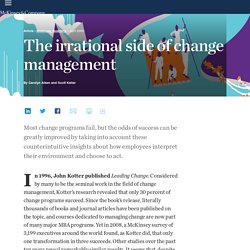
In 1996, John Kotter published Leading Change. Considered by many to be the seminal work in the field of change management, Kotter’s research revealed that only 30 percent of change programs succeed. Since the book’s release, literally thousands of books and journal articles have been published on the topic, and courses dedicated to managing change are now part of many major MBA programs. Yet in 2008, a McKinsey survey of 3,199 executives around the world found, as Kotter did, that only one transformation in three succeeds. Other studies over the past ten years reveal remarkably similar results. Are You Ignoring The Elephant In The (Change) Room? - Change! - Change Management News & Tips.
Purging the meeting of the Pesky Pachyderm There’s an elephant lurking in our office.

Some say it’s pink and others claim they’ve seen it parading in the corridor wearing a top-hat. What is certain is that this big grey idea invading our comfort zones is very real. In every company there is that topic that, once mentioned, is followed by an uncomfortable silence. The four building blocks of change. Four key actions influence employee mind-sets and behavior.
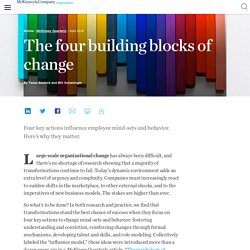
Here’s why they matter. Large-scale organizational change has always been difficult, and there’s no shortage of research showing that a majority of transformations continue to fail. Today’s dynamic environment adds an extra level of urgency and complexity. Companies must increasingly react to sudden shifts in the marketplace, to other external shocks, and to the imperatives of new business models. The stakes are higher than ever. So what’s to be done? Digital technologies and the changing nature of the workforce have created new opportunities and challenges for the influence model (for more on the relationship between those trends and the model, see this article’s companion, “Winning hearts and minds in the 21st century”).
Infographic: Why Employees Resist Change - Catherine's Career CornerCatherine's Career Corner. Save By Catherine Adenle Reasons why employees resist change We all belong to a society steeped in change and the thought of any change could be de-stabilising for some us.
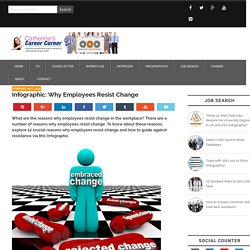
Changes in the economy and the global business environment have forced organizations to change or overhaul the way they work and do business. What successful transformations share: McKinsey Global Survey results. When organizational transformations succeed, managers typically pay attention to “people issues,” especially fostering collaboration among leaders and employees and building capabilities.
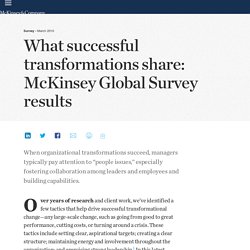
Over years of research and client work, we’ve identified a few tactics that help drive successful transformational change—any large-scale change, such as going from good to great performance, cutting costs, or turning around a crisis. These tactics include setting clear, aspirational targets; creating a clear structure; maintaining energy and involvement throughout the organization; and exercising strong leadership. The ‘how’ of transformation. Change Management Models. Resistance to change. The Beliefs that Built a Global Brewer - James Allen. By James Allen | 11:52 AM April 27, 2012 Anheuser Busch InBev (AB InBev) announced its annual financial results this month and they are impressive, especially for a company with roots as a small brewer in Sao Paolo, Brazil.

Now the largest beer company in the world, AB InBev reported a double digit EBITDA growth rate and almost 30% growth in earnings per share. And yet, in announcing those numbers, management confessed: “We know we can do better. A fundamental part of our culture is never entirely being satisfied with our results: we always challenge ourselves to dream bigger and achieve more.” That’s AB InBev in a nutshell: a relentless focus on achieving bottom line results, coupled with a ‘desire to dream.’ Observers tend to overlook the “dream” talk and chalk up AB InBev’s extraordinary success to its relentless cost cutting culture. Implications for Practitioners Using the Burning-Platform Metaphor. With the previous three posts as a foundation, the following implications may be helpful for change practitioners who wish to use the burning-platform metaphor in their work. 1.

When real burning-platform urgency is at hand (due to either current or anticipated problems or opportunities), it means people believe the penalty for not realizing the intended outcomes is significantly higher than the investment for doing so. - Current problems attract attention more easily but they usually provide only limited options. Five Questions That Should Shape Any Change Program - Scott Keller and Colin Price.
By Scott Keller and Colin Price | 11:48 AM December 2, 2011 Most organizations will shrink or disappear in the long term: only a third of excellent companies remain excellent for decades, and when organizations try to transform themselves, even fewer succeed.

But as economic, political, social, and technological change continue to accelerate, and competitive pressure grows more intense, leaders can’t afford those odds. The likeliest way to overcome them, we found as we wrote Beyond Performance, is to address the underlying problem: organizations that focus too much on short-term financial performance, at the expense of organizational health, are those that most typically need transformational change; but, unfortunately, the change programs they create are similarly shortsighted. Change programs that succeed, we’ve seen, put an equal emphasis on both performance and health in answering five basic questions that should shape any change program. Organization and Change. Methods, Models and Theories. Change Management Learning Center - Prosci. Skate where the Organizational Change Puck will be. What makes a good change agent? - Management Portal.
What Makes a Good Change Agent?

Dagmar Recklies Change processes and change projects have become major milestones in many organizations’ history. Due to the dynamics in the external environment, many organizations find themselves in nearly continuous change. The scope reaches from smaller change projects in particular sub business units up to corporation-wide transformation processes. Unfortunately, not every change process leads to the expected results. In the light of the many problems and risks associated with change projects, the change agent has a very important function. The following article describes required capabilities of good change agents. Organization - Change Management articles from McKinsey Quarterl. Change Management Strategy: Use Social Media. If constant change is the new normal, what then is the strategy that you can adopt to cope within a world of rapid change?
The answer is Change Management. Corporate Training Video Production. If I can watch it, why read? There is a video on the Internet for learning almost any skill, in most languages of the world. With user preferences clearly towards “on the go” videos, organizations are moving quickly to migrate and develop their training content to use this new medium and reach out to all their employees, even in remote locations. However, there is more to creating and delivering Video-based Learning content than simply shooting a few videos and hosting them on the company intranet. Our Offerings. Celeste Headlee: 10 ways to have a better conversation.
Amy Cuddy: Your body language shapes who you are. How Culture Drives Behaviours. Margaret Heffernan: Why it's time to forget the pecking order at work. 20 Insightful TED Talks About Organizational Culture.
Half of Employees Don’t Feel Respected by Their Bosses. When it comes to garnering commitment and engagement from employees, there is one thing that leaders need to demonstrate: Respect. That’s what we saw in a study of nearly 20,000 employees around the world (conducted with HBR and Tony Schwartz). In fact, no other leader behavior had a bigger effect on employees across the outcomes we measured. Being treated with respect was more important to employees than recognition and appreciation, communicating an inspiring vision, providing useful feedback — even opportunities for learning, growth, and development.
How Changing One Habit Helped Quintuple Alcoa's Income. Enterprise Culture. Culture and Change. Change Management. Change Management. Organisational Culture Assessment. Organisational Culture Assessment.
PDHPE-First Aid. Workplace ergonomics experts. Wednesday, May 21st, 2014 at 2:00 p.m. Safety and Risk Management. Are you ready for the revised AS1657 on walkways, ladders and platforms? « SafetyAtWorkBlog. A guest post by Carl Sachs. New discussion Rethinking Leadership in Risk - johnkdavey - Gmail.